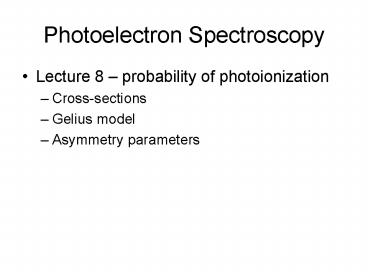Photoelectron Spectroscopy PowerPoint PPT Presentation
1 / 13
Title: Photoelectron Spectroscopy
1
Photoelectron Spectroscopy
- Lecture 8 probability of photoionization
- Cross-sections
- Gelius model
- Asymmetry parameters
2
Ionization is still a transition between states
- Initial State Neutral (or anion)
- Final State Atom/Molecule/Anion after an
electron is removed, plus the ejected electron - M ? M e-
- ?init M ?final M e-
- Transition Probability ? ?init m ?final d?
- For direct photoionization, transition
probability is always gt 0 - Photoionization probability is typically
described in terms of a cross-section (much more
on this later)
3
Photoionization Cross-section
- The probability per unit area, per unit time that
a photon of a given energy can be absorbed by an
atom to excite the photoelectrons. - Fictitious area representing the fraction of
incoming photons that will be absorbed in the
photoionization process. - Unit barn (10-24 cm2)
- or megabarn (10-18 cm2)
photons absorbed per unit time
cross-section
incident photon flux
4
Partial Photoionization Cross-sections
- If more than one orbital level is excited, then
the cross-section becomes the summation of
partial photoionization cross-sections (PPCS) - PPCSs are a function of the photoelectrons
kinetic energies, and therefore are a function of
the incident photon energies. - When PPCS is measured at a specific angle, it is
called a differential cross-section, ds/d?, which
is related to snl by an asymmetry parameter,
?(h?) - This specific equation is for a randomly-oriented
ensemble of atoms in an unpolarized field.
5
Calculated atomic orbital ionization
cross-sections
J.J. Yeh and I. Lindau, At. Data Nucl. Data
Tables 1985, 21, 1.
6
So far weve only talked about atoms what about
molecules?
- Gelius model cross-section behavior of
molecular orbitals is dependent on the atomic
orbital character from which the MO is comprised. - (Gelius and Siegbahn, Faraday Discuss. Chem.
Soc., 1972, 257.)
7
Variable photon synchrotron studies Green has
collected data on ferrocene at 25 different
photon energies from 20-120 eV.
Branching Ratios Ratio of band intensities as
a function of photon energy.
Photoionization Cross-Sections A Guide to
Electronic Structure, J. C. Green and P.
Decleva, Coord. Chem. Rev. 2005, 249, 209-228.
8
(No Transcript)
9
Electronic Structure of Ferrocene
What is the point group?
Looking down the Cp-Fe-Cp vector Cps can lie in
two extreme conformations
staggered
eclipsed
D5h
D5d
d orbitals transform as a1, e1, e2
d orbitals transform as a1g, e1g, e2g
Were going to use these labels
10
Metallocene Ligand ? Group Orbitals
(Cp)22- (D5d)
Cp- (D5h)
e "
e2g
2
e2u
e "
1
e1g
e1u
a1g
a2u
11
(Cp)22-
M2
(Cp)2M
Cp-
e1u
a2u
4p
e2g
(a2ue1u)
e2u
a1g
e
"
4s
2
e2u
e2g
a1g
e1g
?
3d
e2g
e1g
(a1ge1g e2g)
a1g
e
"
1
e1u
e1u
e1g
a2u
a
"
a2u
2
a1g
a1g
12
Asymmetry Parameters
? 90
2
? 54.73
1
0
-1
? 0
? 180
13
Photoelectron Imaging

